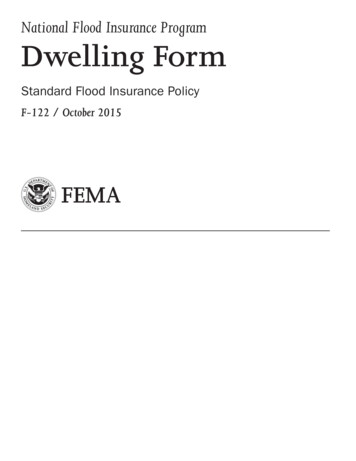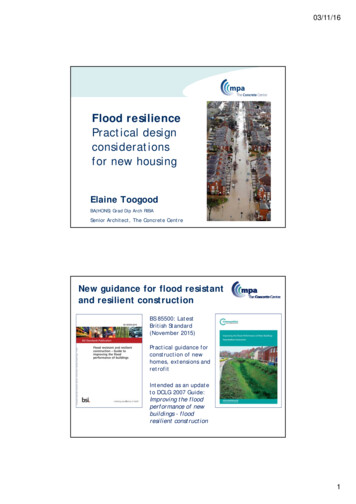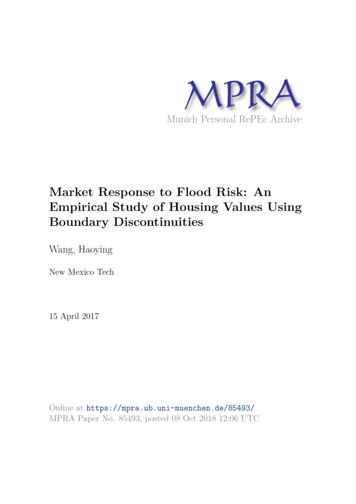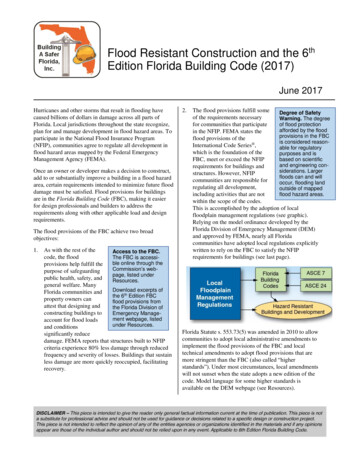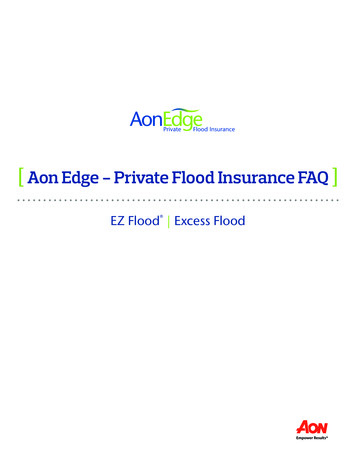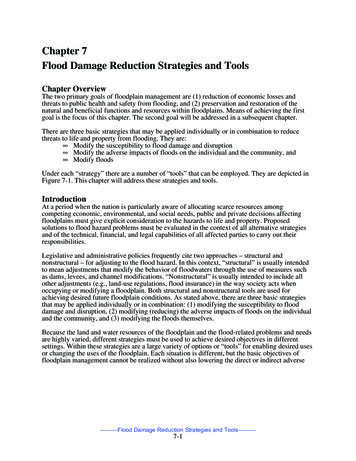
Transcription
Chapter 7Flood Damage Reduction Strategies and ToolsChapter OverviewThe two primary goals of floodplain management are (1) reduction of economic losses andthreats to public health and safety from flooding, and (2) preservation and restoration of thenatural and beneficial functions and resources within floodplains. Means of achieving the firstgoal is the focus of this chapter. The second goal will be addressed in a subsequent chapter.There are three basic strategies that may be applied individually or in combination to reducethreats to life and property from flooding. They are: Modify the susceptibility to flood damage and disruption Modify the adverse impacts of floods on the individual and the community, and Modify floodsUnder each “strategy” there are a number of “tools” that can be employed. They are depicted inFigure 7-1. This chapter will address these strategies and tools.IntroductionAt a period when the nation is particularly aware of allocating scarce resources amongcompeting economic, environmental, and social needs, public and private decisions affectingfloodplains must give explicit consideration to the hazards to life and property. Proposedsolutions to flood hazard problems must be evaluated in the context of all alternative strategiesand of the technical, financial, and legal capabilities of all affected parties to carry out theirresponsibilities.Legislative and administrative policies frequently cite two approaches – structural andnonstructural – for adjusting to the flood hazard. In this context, “structural” is usually intendedto mean adjustments that modify the behavior of floodwaters through the use of measures suchas dams, levees, and channel modifications. “Nonstructural” is usually intended to include allother adjustments (e.g., land-use regulations, flood insurance) in the way society acts whenoccupying or modifying a floodplain. Both structural and nonstructural tools are used forachieving desired future floodplain conditions. As stated above, there are three basic strategiesthat may be applied individually or in combination: (1) modifying the susceptibility to flooddamage and disruption, (2) modifying (reducing) the adverse impacts of floods on the individualand the community, and (3) modifying the floods themselves.Because the land and water resources of the floodplain and the flood-related problems and needsare highly varied, different strategies must be used to achieve desired objectives in differentsettings. Within these strategies are a large variety of options or “tools” for enabling desired usesor changing the uses of the floodplain. Each situation is different, but the basic objectives offloodplain management cannot be realized without also lowering the direct or indirect adverse———Flood Damage Reduction Strategies and Tools———7-1
Management Strategies – Flood Loss ReductionI.Modify Susceptibility to Flood Damage and DisruptionA.B.C.D.E.II.Modify the Impact of Flooding on Individuals and the CommunityA.B.C.D.E.III.Floodplain Regulations1. Zoning Ordinances2. Subdivision Regulations3. Building Codes4. Housing Codes5. Sanitary and Well Codes6. Other regulatory toolsDevelopment and Redevelopment Policies1. Services and Utilities2. Land Rights, Acquisition, Open Space3. Redevelopment and Urban Renewal4. Evacuation/RelocationDisaster Preparedness, Assistance, and Recovery“Floodproofing”Flood Forecasting and Warning/Emergency PlansInformation and EducationFlood InsuranceTax AdjustmentsFlood Emergency MeasuresPost-Flood RecoveryModify FloodingA.B.C.D.E.F.G.Dams, ReservoirsDikes, Levees, FloodwallsChannel AlterationsHigh-Flow Diversions and SpillwaysLand TreatmentOnsite DetentionShoreline Protection MeasuresFigure 7-1. Flood loss reduction management strategies.———Flood Damage Reduction Strategies and Tools———7-2
impacts of flood losses on the individual and the community to an acceptable level. In almostevery community, some combination of strategies and tools is required to achieve the desiredmanagement objectives.Although these strategies and associated tools for floodplain management may be used to guidepublic and private decision makers, there is a prerequisite and perhaps less obvious challenge,that of understanding the overall area’s needs and goals. Meeting this challenge requiresformulation of assumptions about the future development of the area and region as well assensitivity to impacts beyond the immediate consequences of an action. For example, in the past,flood-modifying works frequently failed to account for indirect social costs (e.g., displacement)and environmental resources destroyed, although both represent costs passed on to the public. Inrecent decades there has been a trend toward increased reliance on nonstructural measures andless reliance on structural measures to address flood losses.It must be realized, however, that some degree of flood loss potential remains, regardless of howcarefully floodplain management programs are formulated. Appropriate selection from thefollowing strategies and tools is predicated on these understandings.Modify Susceptibility to Flood Damage and DisruptionThe strategy to modify susceptibility to flood damage and disruption consists of actions to avoiddangerous, uneconomic, undesirable, or unwise use of the floodplain. Responsibility forimplementing such actions rests largely with the non-federal sector.These actions include restrictions in the mode and the time of day and/or season of occupancy; inthe ways and means of access; in the pattern, density and elevation of structures and in thecharacter of their materials (structural strength, absorptiveness, solubility, corrodibility); in theshape and type of buildings and their contents; and in the appurtenant facilities and landscapingof the grounds. The strategy may also necessitate changes in the interdependencies betweenfloodplains and surrounding areas not subject to flooding, especially interdependencies regardingutilities and commerce.Implementing “tools” for these actions include land use regulations, development andredevelopment policies, floodproofing, disaster preparedness and response plans, and floodforecasting and warning systems. Land treatment measures, although discussed later in thestrategy to “Modify Flooding,” can also function to modify susceptibility to flood damage.Different tools may be more suitable to developed or underdeveloped floodplains or to moreurban or rural areas.Floodplain Regulations1Floodplain regulations are efficient tools for modifying future susceptibility to damage or loss,both on floodplains that are not fully developed and on highly developed floodplains where olderstructures are being rehabilitated. By providing direction to growth and change, regulations areparticularly well-suited to preventing unwise floodplain occupancy. Land use regulations requirethat individuals recognize the general welfare when making decisions. Legal treatment offloodplain regulations and their adoption will be addressed in a subsequent chapter. Acombination of regulatory tools is necessary to control development in floodplains, and they arefrequently utilized in combination with other techniques.Floodplain regulations which are part of broader land use regulations can be applied effectivelyonly by state and community action. They are often required under ongoing federal programs(e.g., National Flood Insurance Program) as a prerequisite to other assistance. Administration of1Land-use regulations for floodplain management, introduced here, will be covered in greater detail in Chapter 15.———Flood Damage Reduction Strategies and Tools———7-3
floodplain regulations adds only a small incremental cost where other ordinances are alreadybeing administered and these costs are characteristically small in relation to the flood damageproblem.To some degree, individual opportunity foregone is a cost of all land use regulations. The neteconomic cost, i.e., reflecting externality costs, of reducing the intensity of use may be large orsmall. This cost depends on the availability of alternatives to a floodplain location.To be effective regulations must be based on sound and suitable technical data, must be equitablyapplied, and should permit reasonable use of the land (not necessarily highest economic return).Provisions have to be made to handle “nonconforming uses,” i.e., construction or use thatoccurred before adoption of regulations and that now do not conform to the regulations.The regulatory aspects of floodplain management programs are sensitive to political pressuresfor change in favor of individuals, but they can be effective when equitably reinforced at allgovernment levels. Several types of “police power” regulation are in use in some states andnearly all localities to regulate land uses in flood hazard areas.A number of states require their local units of government to regulate floodplain developmentconsistent with minimum state objectives and standards. They and other states may also provideadvice and assistance in understanding, interpreting and enforcing regulations. Many state boardsof health regulate the use of private and public waste disposal systems. Some prohibit privatesystems in areas subject to high groundwater or flooding.The principal local control of flood hazard areas is through zoning, subdivision regulations,building and housing codes, and sanitary codes with specific flood hazard provisions.Zoning divides a government unit into specified areas for the purpose of regulating (a) the use ofstructures and land, (b) the height and bulk of structures, and (c) the size of lots and density ofuse. Zoning may be used to set special standards for land uses in flood hazard areas includingspecification of minimum floor elevations to place them above expected flood levels. Floodplainzoning is commonly single district (all of the designated floodplain in a special district) or twodistrict (division of the floodplain into the “floodway” and “flood fringe”).Administration of riverine floodplain zoning ordinances is simplified by the designation offloodway or floodplain encroachment limits. Floodway limits are designated, as part of theplanning process, so that any development that is permitted in the remainder of the floodplain(i.e., within the flood fringe) will not result in a flood stage increase over a prescribed amount(usually one foot) of a specified frequency flood (usually the 1 percent annual chance flood) atany location along the studied stream. These measures are illustrated in Figure 7-2.———Flood Damage Reduction Strategies and Tools———7-4
Figure 7-2. Illustration of floodplain regulation terms.Although the floodway concept does not apply in coastal areas, there is a parallel for high hazardcoastal and lakeshore areas where the major forces of tides and waves come into play and whereerosional changes are at a maximum during flooding. The National Flood Insurance Programdesignates such areas as “coastal high hazard areas” on maps they prepare for coastalcommunities.Subdivision regulations guide the division of large parcels of land into smaller lots for thepurpose of sale or building. Often the community’s jurisdiction is extended beyond itsboundaries by subdivision-enabling legislation. Such extension provides coverage usuallyunavailable through zoning.Subdivision regulations guide the process of land division to ensure that lots are suitable forintended use without putting a disproportionate burden on the community. They also controlimprovements such as roads, sewers, water, and recreational areas. Subdivision regulations oftenrequire (a) installing adequate drainage facilities, (b) showing the location of flood hazard areason the plat, (c) avoiding encroachment into floodplain areas, (d) determining the most———Flood Damage Reduction Strategies and Tools———7-5
appropriate means of elevating a building above the regulatory flood height in accordance withsound engineering practice, and (e) placing streets and public utilities relative to the selectedflood protection elevation. These provisions are illustrated in Figure 7-3.Building Codes regulate neither the location nor the type of development; rather, they controlbuilding design and use of construction materials. Building codes can reduce flood damages tostructures by setting specifications to (a) require suitable anchorage to prevent flotation ofbuildings during floods; (b) establish minimum protection elevations for the first floors ofstructures; (c) require electrical outlets and mechanical equipment to be above regulatory floodlevels or be appropriately “floodproofed” (described later); (d) restrict use of materials thatdeteriorate when wetted; and (e) require an adequate structural design, one that can safelywithstand the effects of water pressure and flood velocities. General floodproofing requirements(as performance standards) are sometimes included in floodplain zoning ordinances rather thanin building codes. Building codes have an added value in that they also may be used to requireflood protection to below-ground spaces in areas beyond the regulatory area but still within thezone of sewer backup and flood-elevated groundwater.Housing Codes like building codes, set minimum standards for construction, but they also setminimum standards for maintenance of structures. These may be used to require repair of flooddamaged structures in a manner that will ensure the safety of occupants and prevent blight.Sanitary and Well Codes establish minimum standards for waste disposal and water supply.Sanitary codes commonly prohibit onsite waste disposal facilities such as septic tank systems inareas of high groundwater and flood hazards. Sometimes elevation or floodproofingrequirements are established for public sewer systems. Well codes often establish specialfloodproofing requirements for facilities located in flood hazard areas in order to reduce theirpotential for contamination during flooding.Other Regulatory Tools are available to reduce flood losses and promote sound management offlood prone lands. Special statutes may require that sellers or real estate brokers disclose floodhazards on marketed lands. Interstate Land Sales Registration statements of natural hazardsprotect buyers or potential buyers unfamiliar with the area. Official maps designate areas wherestructural development is planned for reservoirs, dikes, levees, parks, or other public areas.Development and Redevelopment PoliciesOther public actions not necessarily employing the police power can modify susceptibility toflood damage and guide development in a manner that takes into account the flood hazard andnatural characteristics of the floodplain. Such actions may be applied at the local, state, andfederal levels through the design and location of utilities and services, through policies of openspace acquisition and easement, and through redevelopment or permanent evacuation. Thesemeasures are normally required in any viable community, but in this context they should reflectthe flood hazard. They can often be more effective than local land use regulations.Design and Location of Services and Utilities reduce flood loss potentials by guiding private andpublic developments (hence public services and utilities) to low risk areas or areas not subject toflooding. Local governments can exercise discretion in extending roads or sewer and watermains or their access in flood hazard areas. Locating libraries, schools, post offices, and otherpublic and government facilities away from the flood hazard area not only lessens the possibilityof flood damages to such buildings but prevents them from otherwise encouraging privatedevelopment in areas prone to flooding.———Flood Damage Reduction Strategies and Tools———7-6
Figure 7-3. Typical floodplain subdivision before and after site preparation.Land Rights, Acquisition, and Open Space Use lessen the potential for flood losses and theirconsequences. Land is purchased directly, or control is purchased through easements or———Flood Damage Reduction Strategies and Tools———7-7
development rights, for the purpose of precluding future uses incompatible with floodplainmanagement programs and for the purpose of providing open space. In the short run, acquisitionmay be a costly substitute for regulation but the best tool in certain circumstances, and it may bethe only acceptable approach if the proposed use has a specific non-flood-related purpose, suchas for public use areas. Easements are being used in some situations to continue agricultural orundeveloped use of the land, particularly where development pressures are high. Regulationscannot be used to change ownership from private to public.Redevelopment may offer a tool for improving floodplain areas blighted for reasons that may ormay not include exposure to flooding. Usually the motives for redevelopment are broader thanjust flood damage reduction. However, the principles of floodplain management can beaccomplished in the process. Disaster assistance, urban redevelopment, economic development,and other community development activities should be coordinated in such situations. Theopportunities for and justification of redevelopment should not be overlooked. Redevelopmentmay help to achieve at least some of the floodplain management objectives by improving botheconomic efficiency and the natural environment.Permanent Evacuation, like redevelopment, of which it may in fact be part, is increasingly beingcarried out in the aftermath of federally-declared flood disasters. Several thousand flooddamaged structures were acquired and removed from the floodplain after the 1993 Midwestflood and after Hurricane Floyd caused extensive flooding in eastern North Carolina in 1999.The cleared land, intended for open space uses, was transferred to local governments withpermanent restrictions on resale or placement of any future structures. Principally the federalgovernment provided funding, usually on a 75-25 or 90-10 cost-share ratio with state and localgovernments. In other instances structures and facilities are relocated from floodways and otherperilous flood prone areas. In a number of cases, permanent evacuation of floodplain areas maybe the only economically feasible alternative.Disaster PreparednessPreparedness plans and programs provide for pre-disaster mitigation, warning and emergencyoperations. Training at all levels, public information activities, and readiness evaluations are alltools available within disaster preparedness. Coordination of local, state and federal disasterpreparedness plans and programs is essential. Success is closely associated with the degree towhich individuals, local governments, and states protect themselves by taking appropriate hazardmitigation measures and obtaining flood insurance coverage to supplement or replacegovernment assistance.Disaster AssistanceDisaster assistance may be provided by federal, state, or local governments and certain nonprofitorganizations to repair, replace, or restore facilities damaged or destroyed by a disaster. Intoday’s political climate, federal assistance is usually available to assist state and localgovernments in the recovery effort. Relief and recovery efforts from the public and privatesectors help individuals, business owners, and the community after a flood. Initial measuresinclude cleanup and resumption of services, followed by longer-term recovery measures.Post disaster evaluation may provide the opportunity for the implementation of innovative hazardmitigation strategies. Usually a percentage (10-15) of total disaster funds made available by thefederal government is designated for mitigation measures. Flexibility may exist to constructother needed facilities in lieu of restoring the damaged or destroyed facilities. Permanentrestorative work to rebuild damaged facilities should be in conformity with applicable codes,specifications, plans, and standards. Acquisition of properties that have been frequently orextensively damaged also should be considered.———Flood Damage Reduction Strategies and Tools———7-8
Disaster RecoveryWhile it is most desirable to develop preparedness and recovery programs prior to flooddisasters, the opportunity should be seized when such disasters occur to design recovery andredevelopment activities that will reduce or eliminate future flood hazards. This is particularlyimportant during the brief “window of opportunity” after a disaster when public interest, politicalsupport, and the availability of outside assistance are at their highest levels.FloodproofingFloodproofing can provide for development in lower risk floodplain areas by keeping damagewithin acceptable limits. It can be chosen by an individual or government agency for existingstructures as well as new construction.Floodproofing consists of modifications of structures, their sites, and building contents to keepwater out or reduce effects of water entry. Such adjustments can be installed when buildings areunder construction or during repair, remodeling, or expansion of existing structures.Floodproofing may be permanent (e.g., bricked-in openings) or it may be contingent on someaction at the time of the flood. The adjustment may be by elevation (on fill or open work such aspiling), by appropriately constructed ring dikes or their equivalent, or by water proofing (closure,seals, pumps, valves or pipes), or other measures. Some possible measures are illustrated inFigure 7-4.Like other methods of adjusting to floods, floodproofing has limitations. It can generate a falsesense of security, and residual losses may be very high. A primary purpose of floodproofingstructures is to reduce property losses and to provide for early return to normalcy after floodshave receded rather than for continuous occupancy. Only very substantial and self-containedstructures should be occupied during a flood. Unless correctly used, floodproofing can increaseunwise use of floodplains. Applied to structurally unsound buildings, it can result in moredamage than would occur without floodproofing, in part because of the false sense of securityand resultant inappropriate actions and decisions. The application of economic criteria is morelikely to justify floodproofing for commercial structures than for residential structures. Usually itis applied to individual structures, but it is only partially effective unless it is also applied tomeans of access. Access to buildings should be passable at least in floods up to the magnitudeused in setting floodproofing elevations. Floodproofing should never protect some propertyowners while aggravating the hazard for others.———Flood Damage Reduction Strategies and Tools———7-9
Figure 7-4. Possible floodproofing measures.The U.S. Army Corps of Engineers established a National Floodproofing Committee around1990 to advance knowledge and application of floodproofing. The committee has developed andpublished a number of manuals on the subject. Among Corps publications is a detailed manualon———Flood Damage Reduction Strategies and Tools———7-10
floodproofing concepts, in model building code format. The manual cover is reproduced asFigure 7-5. Some of its contents will be utilized in a more detailed discussion of floodproofingin Chapter 16.Figure 7-5. U.S. Army Corps of Engineers manual.Flood Forecasting and Warning Systems and Emergency PlansFlood forecasting systems have been established for the major river systems in the United States.These systems provide information on the time of occurrence and magnitude of flooding to beexpected. On major rivers where the flood crest moves slowly, warnings are provided severaldays to a few weeks in advance of the event. For smaller tributaries, warning times decrease to amatter of a few hours and probably not more than a day or two at a maximum. On shortheadwater streams with steep channel gradients, flash flood warnings may be possible only a few———Flood Damage Reduction Strategies and Tools———7-11
hours or even a few minutes in advance of the event. Community warning systems can beestablished for such conditions, but the short interval available for warning and responsedemands even tighter advance planning and preparedness than is required for areas with longerwarning periods.The effectiveness of flood watches (possibility of flooding) and warnings (imminent oroccurring) depends upon the effectiveness of their dissemination to the public, the time available,and the actions taken in response. At a minimum, local officials, police, fire and rescue squads,and radio and television stations are notified. They are also issued on weather Internet sites.Warnings must be effectively presented.The success of flood forecasting and flood warning systems depends upon having an emergencyaction plan and attendant implementing organization in place before a flood occurs. The floodprone community must look upon the emergency action plan as its plan since only the localcommunity can make the plan work. The emergency action plan must recognize that as thelength of warning period decreases, the opportunity for emergency action including temporaryevacuation diminishes accordingly. In many cases contingency and emergency floodproofingand the removal of goods and inhabitants are possible with sufficient warnings, but flash floodsmay permit only the evacuation of inhabitants.Modify the Impact of Flooding on Individuals and the CommunityA second strategy for mitigating flood losses consists of actions designed to assist individualsand communities in their preparatory, survival, and recovery responses to floods. Tools includedissemination of information and education, arrangements for spreading the costs of the loss overtime, and purposeful transfer of some of the individual’s loss to the community. The distinctionbetween a reasonable and unreasonable transfer of costs from the individual to the community,as described under the preceding section on regulations, is a key element.Information and EducationFlood hazard information is a prerequisite to sound floodplain management. The development ofneeded technical information and public education, especially by or for the officials and plannerswho will have the major task of interpreting and applying it, are essential in an effectivefloodplain management program. Although available in many forms and from many sources,such information is neither of uniform quality nor available for all areas. Vital informationincludes the hydrology and hydraulics of small, large, and very large floods on the areas subjectto inundation, on the floodplain’s resource attributes, on the role of the floodplain within itsregion, and on the potential impact of land use decisions on expected flooding. From thisinformation, responsible government and private decision makers can formulate alternativefloodplain management approaches. Better information on property at risk and probabilities ofvarious levels of damage or loss can help to translate the hazard into terms that stimulateappropriate local action. Federal, state, and local agencies and private consultants are allproviding this sort of information, with major emphasis on the more technical aspects of riskanalysis provided principally by the federal agencies.With this said, a major conundrum is how to organize information into educational programsthat target citizens in flood risk areas of our country?What we have today is a widespread problematic interpretation of the term “100-year flood.”One authority noted that every floodplain manager he’s talked to has a story about how peoplemisunderstand it.University of Arizona hydrologist Dr. Victor Baker even calls it “the most spectacular failure ofpublic communication for any scientific concept of our time.” Some floodplain experts have———Flood Damage Reduction Strategies and Tools———7-12
now come to use the term “one percent” but it is not widely known or used by the public, banks,realtors, etc. He notes that this term swirls in a larger maelstrom of floodplain demarcation,property rights and political chess that usurp precious time and attention from developing a moreinformed citizenry.Flood InsuranceInsurance is a mechanism for spreading the cost of losses both over time and over a relativelylarge number of similarly exposed risks. Until 1969, insurance against flood loss was generallyunavailable. Under the National Flood Insurance Program (NFIP), initiated in 1968 andsignificantly expanded in 1973, the federal government makes flood insurance available forexisting property in the flood hazard area. In return, participating localities must enact andenforce floodplain management regulations designed to reduce future flood losses and regulatenew development in the designated flood hazard area in accordance with the calculated risk. Theregulations must, at a minimum, be consistent with NFIP criteria.By emphasizing the long-term advantages of wise floodplain use and by providing a mechanismfor widespread risk sharing, the National Flood Insurance Program provides persuasive strengthand beneficial emphasis to local floodplain management. First layer insurance coverage is madeavailable at subsidized rates to property owners whose location decisions and buildingconstruction were completed before identification of the specific nature and extent of their floodhazard. First and second layer insurance coverage is made available at actuarial rates to propertyowners of new buildings. Insurance may not be sold in areas designated under the CoastalBarrier Resources Act (covered in a subsequent chapter). Specific information is provided topotential owners of floodprone properties about the economic costs of locational decisions, andthus serves to discourage unwise construction in hazardous floodplain areas. The program’sfloodplain management provisions help reduce flood losses and the dependency upon publicsupport. The NFIP will be covered in more detail
strategy to "Modify Flooding," can also function to modify susceptibility to flood damage. Different tools may be more suitable to deve loped or underdeveloped floodplains or to more urban or rural areas. Floodplain Regulations 1 Floodplain regulations are efficient tools for modi fying future susceptibility to damage or loss,


